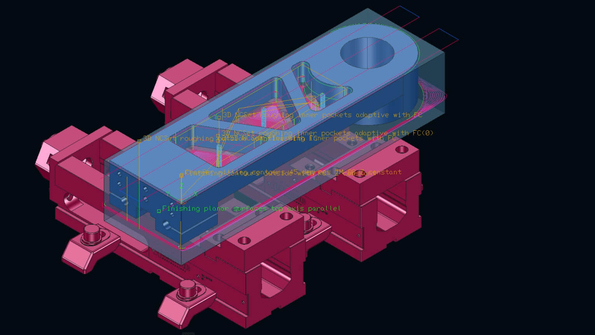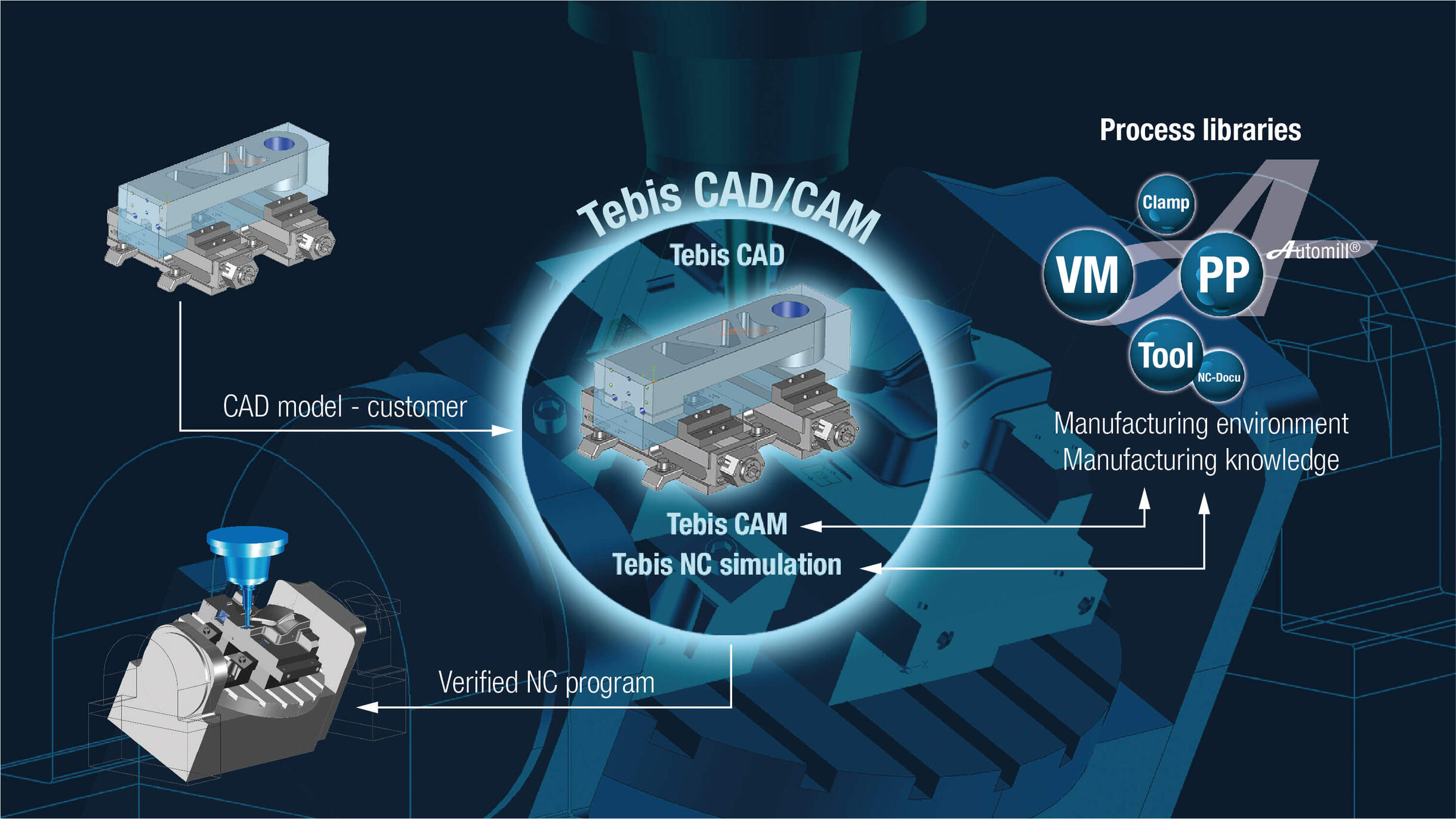-
Software
-
CAM software
- Tebis Automill
- CNC programming
- CNC automation
- CNC simulator
- Multiple setup
- Robotic machining
- CNC drilling
- Deep-hole drilling
- Combined turn-milling
- CNC turning
- Turn-milling
- 2.5D milling
- 3D milling
- 5-axis milling
- Slot milling
- Trimming
- HPC milling
- HFC milling
- Circle-segment cutters
- Sinker EDM
- Wire EDM
- 3D laser cutting
- Laser hardening
- Laser weld cladding
- CAD software
- CAQ software
- MES software
- Products
-
CAM software
- Services
- Consulting
- Sectors
- References
- Company
- News

-

How production machining experts manufacture up to 95 percent faster
Seven stations in the manufacturing process that can be quickly and easily automated with an end-to-end CAD/CAM software application
Manufacturing companies rely on digitalization and automation in particular to improve flexibility and efficiency. If you only focus on the machine, you're only looking at the final step on the overall process. This can waste enormous amounts of time and money in at least six process stations. It's worth it to take a closer look: Because efficiency increases of 10 to 95 percent can be discovered in each station! The key to this efficiency is process automation. It also relieves the burden on your specialists, who can apply the time they’ve saved to other tasks.How CAD/CAM automation can be scaled, and what pays off the most
Simply automating machines isn’t enoughPreviously, machine automation was considered a guarantee of productivity. Today a 5-axis CNC milling machine can machine workpieces extremely quickly. They can be implemented so skillfully that hardly any residual stock remains. Production machining has therefore become increasingly productive. But this is no longer enough to remain competitive over the long term. Starting now, the focus needs to be on process automation in order to improve manufacturing efficiency.
Manufacture faster with smooth subprocessesWhat’s has often been overlooked in the past: The machine is only the final manufacturing station for a workpiece. It’s already passed through up to six process stations in digital form on its journey from design to machine. Because they’re are all working towards manufacturing by machining, this is precisely where modern automation solutions are implemented. Their measures sequentially address the entire process chain in a production machining company. The result: an optimally controlled and stable process with a perfectly coordinated sequence of predefined standards. The first standard in a manufacturing series would be the clustering of parts according to similarities in part classes or families, for example. Efficiency improvements therefore have a direct impact on downstream processes from the first station – with hardly any effort involved.
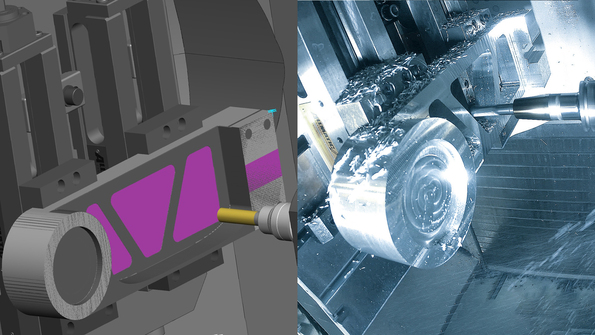 Maximum safety for reduced-personnel manufacturing: In the CNC simulation, the user plans, programs and checks NC machining operations automatically in the CAD/CAM system. The simulator detects potential collisions and limit switch conflicts before the NC output. A safe, optimized, and precise NC program is sent to the machine. This allows you to fully utilize your potential.
Maximum safety for reduced-personnel manufacturing: In the CNC simulation, the user plans, programs and checks NC machining operations automatically in the CAD/CAM system. The simulator detects potential collisions and limit switch conflicts before the NC output. A safe, optimized, and precise NC program is sent to the machine. This allows you to fully utilize your potential.An intelligent part controls its own route through the ideal CAD/CAM process
This can be gone over for the specific example of a digital CAD model of a workpiece. Because all process stations have something in common: They work on and with the CAD model. It’s therefore predestined to intelligently maneuver its way through the process. The practical example highlights the efficiency potential in all stations and illustrates the contribution of an end-to-end CAD/CAM system.
You should automate these seven process stations
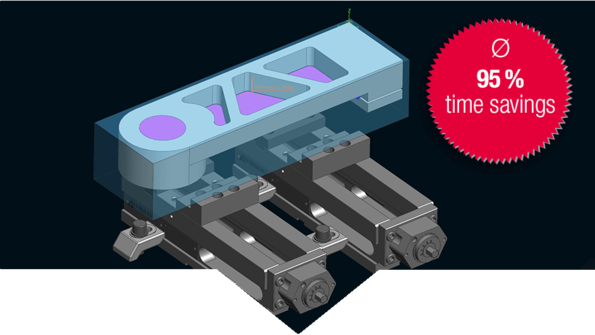
Station 1 – CAD data preparationData preparation starts with importing the CAD data into the CAD/CAM system. All repetitive data preparation tasks are stored there in CAD templates. Templates can be extended as desired, they can be individually configured and they allow manual intervention. All the user needs to do is select the part and define the machining direction. The system automatically performs data preparation and provides the blank, extensions, cover surface, zero point, clamping situation and more. In his blog post, Christian Maier explains in detail how data preparation can be accelerated with CAD templates.
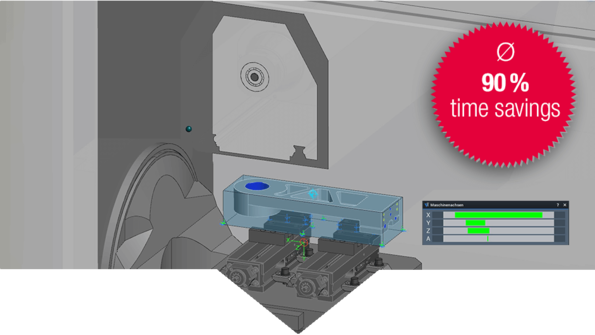 Station 2 – Virtual machine setupParametric setup: The blank, finished part and clamping devices are input from the previous process station. The blank is automatically positioned with the connection points generated there. Plausibility checks verify the result for more complex setups, with few repeats. The CAD/CAM system automatically accesses libraries with tools, clamping devices, preconfigured machines and postprocessors. It therefore works with precise digital twins that include all components and parameters.
Station 2 – Virtual machine setupParametric setup: The blank, finished part and clamping devices are input from the previous process station. The blank is automatically positioned with the connection points generated there. Plausibility checks verify the result for more complex setups, with few repeats. The CAD/CAM system automatically accesses libraries with tools, clamping devices, preconfigured machines and postprocessors. It therefore works with precise digital twins that include all components and parameters.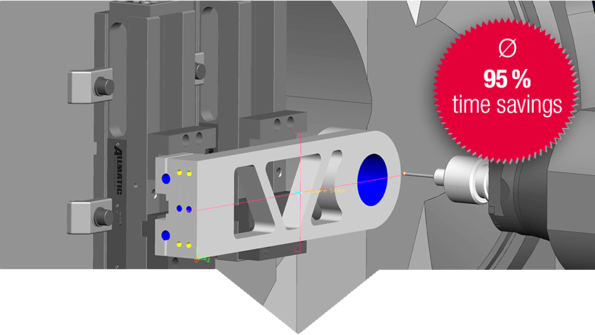 Station 3 – Virtual check of clamping situationThe correct reference point can be determined during CAM programming, instead of in production. The measuring points from data preparation enable the dimensions to be checked and the entire setup to be controlled by the NC program.
Station 3 – Virtual check of clamping situationThe correct reference point can be determined during CAM programming, instead of in production. The measuring points from data preparation enable the dimensions to be checked and the entire setup to be controlled by the NC program.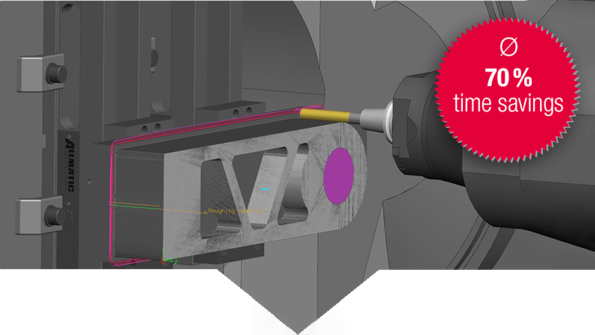 Station 4 – Automatically generate toolpathsThe prepared CAD data flow directly into automated CAM programming. The user's work is simplified by CAM templates that automatically process frequently used NC sequences and technologies. The CAD/CAM system detects features like all 2.5D machining operations in a feature scan. Instead of time-consuming manual work, automatic element selection generates features like the correct holes and threads.
Station 4 – Automatically generate toolpathsThe prepared CAD data flow directly into automated CAM programming. The user's work is simplified by CAM templates that automatically process frequently used NC sequences and technologies. The CAD/CAM system detects features like all 2.5D machining operations in a feature scan. Instead of time-consuming manual work, automatic element selection generates features like the correct holes and threads.
The software accesses libraries where users store proven manufacturing sequences. This means that over time, the production machinist is storing their internal manufacturing knowledge in standardized digital templates. The Job Manager template is generated at the click of a button, including NC-programs and toolpaths. No extra effort is needed, because the job is deactivated if the software doesn't find any milling areas for contact surfaces.
BONUS: While the calculation runs in the background, the user is already working on another part. The result is safe, because an integral NC simulation checks the NC programs for collisions. It verifies the control information right in the CAD/CAM system.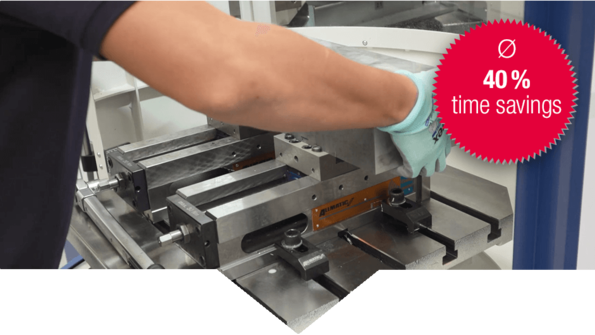 Station 5 – Real machine setupProven NC programs are sent to the machine in control format. The results of the virtual setup are available for the machine operator with no loss of information. The digital documentation provides clear information:
Station 5 – Real machine setupProven NC programs are sent to the machine in control format. The results of the virtual setup are available for the machine operator with no loss of information. The digital documentation provides clear information:- The setup position is defined
- All clamping devices and tools are specified
- Measuring points are defined
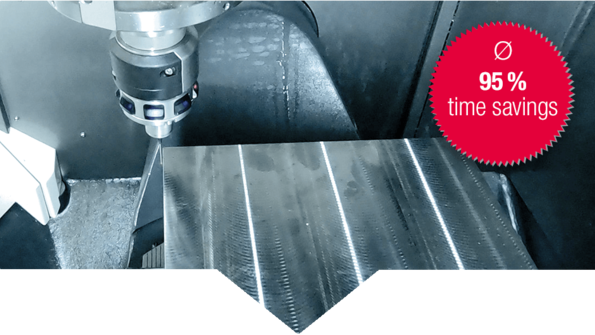 Station 6 – Real checking of clamping situationMeasurement of the part’s zero point is fully automated. The NC program performs checking tasks that have already been set up in the CAD/CAM system. This prevents user error and minimizes setup time. The user can react flexibly to inappropriate clamping situations: The CAM programmer quickly generates an alternative blank with parametric templates. The system automatically adjusts everything else.
Station 6 – Real checking of clamping situationMeasurement of the part’s zero point is fully automated. The NC program performs checking tasks that have already been set up in the CAD/CAM system. This prevents user error and minimizes setup time. The user can react flexibly to inappropriate clamping situations: The CAM programmer quickly generates an alternative blank with parametric templates. The system automatically adjusts everything else.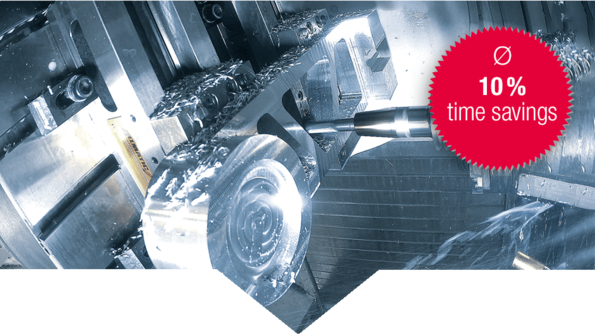 Station 7 – MachiningAfter starting, an optimized, safe and suitable NC program. The potential of the machine can be fully exploited with fast and highly dynamic traverse movements, short tools, the maximum possible feed movements and minimum retract movements. There’s no need for monitoring or programming on the control. The machine operator can attend to other tasks with no concerns about the machining.
Station 7 – MachiningAfter starting, an optimized, safe and suitable NC program. The potential of the machine can be fully exploited with fast and highly dynamic traverse movements, short tools, the maximum possible feed movements and minimum retract movements. There’s no need for monitoring or programming on the control. The machine operator can attend to other tasks with no concerns about the machining.
This is followed by integral quality checking originating in the NC programming. The machine independently reacts to measurement results and automatically processes correction iterations – without tying up resources and with documented measurement results.Make optimal use of resources more easily
CAD/CAM processes with this degree of automation provide high levels of speed, safety and precision – and simultaneously relieve the burden on specialists. Monotonous, repetitive processes are stored in templates, which prevents errors. This type of automation facilitates task assignment: Less-experienced employees can create most of the CAM programs like 2.5D machining and 3-axis roughing programs fully automatically. More experienced users can focus on more complex tasks. This more targeted use of resources and personnel reduces your costs.A service partner for scalable implementation
Production machining manufacturing is already more efficient with automated machines and methods. Production machining manufacturing is already more efficient with automated machines and methods. Another promising prerequisite for manufacturing more efficiently right from the start is the use of part classes or families. This is because parts that are clustered based on similarities follow the same route through CAD, CAM and manufacturing with only minor deviations.
But pressing day-to-day business often limits the implementation of solutions that are viable for the future. In this case, you need a service partner and process supplier who provides you with the necessary flexibility and maximum efficiency through scalable approaches. Process automation in production machining offers up to 95 percent greater efficiency. Scalable automation as a managed service makes this financially accessible for SMMs.
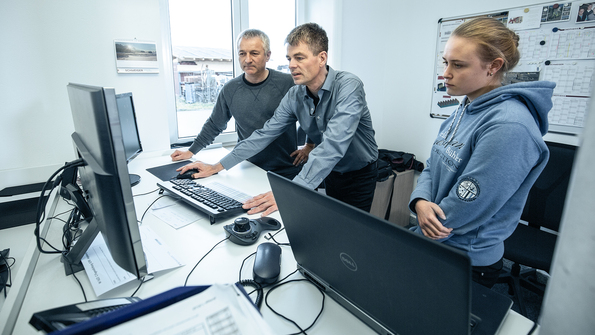
Automation is the future
 Author: Christian Maier, Team Lead for Technical Support, Tebis AG
Author: Christian Maier, Team Lead for Technical Support, Tebis AGAutomation is essential for future viability. Some associate this with the fear of losing their jobs. But: Automation always has its limits. Especially when movement sequences are too complex and protracted or workpieces are too customized. Then human abilities like creativity, flexibility and logical reasoning are needed for making quick decisions.
And beyond that: With scalable automation as a managed service, Tebis supports you and your employees in getting started in process automation and developing it for your specific requirements. This offers valuable opportunities for personnel to expand their knowledge of CAD/CAM automation and adapt their tasks to change. As an experienced service partner and process provider in the industry, we know the value of each individual employee.
The "intelligent part" in CAD/CAM automation:The intelligent part is central to the process. It’s generated from the CAD model in the CAD/CAM system: Most manufacturing-specific information is generated in design, including the material, dimensions, measuring points, tolerances, zero point and clamping situation. This provides digital CAD models with all the information required for automated CAM programming and manufacturing. The intelligent part independently maneuvers itself step by step along the automated CAD/CAM process through all of the process stations to the machine. The CAD/CAM system accesses process libraries with templates, digital twins and knowledge bases containing proven manufacturing processes.

